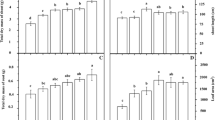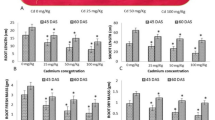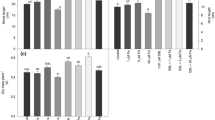Abstract
Cadmium (Cd) is toxic to plants and other living beings present in the next trophic level. It inhibits growth of the plant. Since Brassica juncea is a hyperaccumulator plant for Cd, its consumption is hazardous to living beings. Hence, it is important to reduce the accumulation of Cd inside the foliage of mustard plants to make it safe for consumption and reduce bio-magnification. 24-Epibrassinolide (EBL) was applied in various doses (10–10, 10–8 or 10–6 M) as a foliar spray at 25–30 days stage of growth on Brassica juncea var. Varuna, growing in Cd (25 or 50 mg Kg−1 of soil) amended soil. The sampling was done at 45 and 60 days after sowing (DAS) to determine photosynthesis, nutrients, antioxidants, cell death, enzymatic activities, reactive oxygen species, carbohydrate, and Cd content. EBL restricted the Cd uptake and translocation of Cd from root to shoot and induced defence responses to protect photosynthetic machinery. Out of the three doses, EBL (10–8 M) proved most effective and the effect was more pronounced against lower concentration (25 mg Kg−1 soil) of Cd which persisted at both the stages of sampling. The study suggests that EBL alleviated the adverse effects generated by Cd on physiology of the plant.






Similar content being viewed by others
References
Ahmad P, Sarwat M, Bhat NA, Wani MR, Kazi AG, Tran LSP (2015) Alleviation of cadmium toxicity in Brassica juncea L. (Czern. & Coss.) by calcium application involves various physiological and biochemical strategies. PloS one 10(1):e0114571
Ali B, Hayat S, Ahmad A (2005) Response of germinating seeds of Cicer arietinum to 28-homobrassinolide and/or potassium. Gen Appl Plant Physiol 31(1–2):55–63
Ashraf M, Akram NA, Arteca RN, Foolad MR (2010) The physiological, biochemical and molecular roles of brassinosteroids and salicylic acid in plant processes and salt tolerance. Crit Rev Plant Sci 29(3):162–190
Bagheri R, Ahmad J, Bashir H, Iqbal M, Qureshi MI (2017) Changes in rubisco, cysteine-rich proteins and antioxidant system of spinach (Spinacia oleracea L.) due to sulphur deficiency, cadmium stress and their combination. Protoplasma 254(2):1031–1043
Baker NR, Oxborough K (2004) Chlorophyll fluorescence as a probe of photosynthetic productivity. Chlorophyll a fluorescence. Springer, Dordrecht, pp 65–82
Bates LS, Waldren RP, Teare ID (1973) Rapid determination of free proline for water-stress studies. Plant Soil 39(1):205–207
Campbell NA, Reece JB, Mitchell LG (1999) Biology, 5th edn. Addison Wesley Longman, Reading
Chibuike GU, Obiora SC (2014) Heavy metal polluted soils: effect on plants and bioremediation methods. Appl Environ Soil Sci. https://doi.org/10.1155/2014/752708
Clemens S (2006) Evolution and function of phytochelatin synthases. J Plant Physiol 163(3):319–332
Das S, Goswami S, Talukdar AD (2014) A study on cadmium phytoremediation potential of water lettuce, Pistia stratiotes L. Bull Environ Contam Toxic 92(2):169–174. https://doi.org/10.1007/s00128-013-1152-y
Dalio RJD, Pinheiro HP, Sodek L, Haddad CRB (2013) 24-Epibrassinolide restores nitrogen metabolism of pigeon pea under saline stress. Bot Stud 54(1):9
De Michele R, Vurro E, Rigo C, Costa A, Elviri L, Di Valentin M, Schiavo FL (2009) Nitric oxide is involved in cadmium-induced programmed cell death in Arabidopsis suspension cultures. Plant Physiol 150(1):217–228
Della Rovere F, Piacentini D, Fattorini L, Girardi N, Bellanima D, Falasca G, Altamura MD, Betti C (2022) Brassinosteroids mitigate cadmium effects in arabidopsis root system without any cooperation with nitric oxide. Int J Mol Sci 23(2):825
Di Toppi LS, Gabbrielli R (1999) Response to cadmium in higher plants. Environ Exp Bot 41(2):105–130
Dong Y, Chen W, Bai X, Liu F, Wan Y (2019) Effects of exogenous nitric oxide and 24-epibrassinolide on the physiological characteristics of peanut seedlings under cadmium stress. Pedosphere 29(1):45–59
Dubois M, Gilles KA, Hamilton JK, Rebers PT, Smith F (1956) Colorimetric method for determination of sugars and related substances. Analyt Chem 28(3):350–356
Faraz A, Faizan M, Sami F, Siddiqui H, Hayat S (2019) Supplementation of salicylic acid and citric acid for alleviation of cadmium toxicity to Brassica juncea. J Plant Growth Regul 39:1–15
Fariduddin Q, Hayat S, Ali B, Ahmad A (2006) Effect of 28-homobrassinolide on the nitrate reductase, carbonic anhydrase activities and net photosynthetic rate in Vigna radiata. Acta Bot Croatica 65(1):19–23
Fariduddin Q, Mir BA, Yusuf M, Ahmad A (2013) Comparative roles of brassinosteroids and polyamines in salt stress tolerance. Acta Physiol Plant 35(7):2037–2053
Fariduddin Q, Yusuf M, Ahmad I, Ahmad A (2014) Brassinosteroids and their role in response of plants to abiotic stresses. Biol Plant 58(1):9–17
Foyer CH, Parry M, Noctor G (2003) Markers and signals associated with nitrogen assimilation in higher plants. J Exp Bot 54(382):585–593
Garnier L, Simon-Plas F, Thuleau P, Agnel JP, Blein JP, Ranjeva R, Montillet JL (2006) Cadmium affects tobacco cells by a series of three waves of reactive oxygen species that contribute to cytotoxicity. Plant Cell Environ 29(10):1956–1969
Gill SS, Tuteja N (2011) Cadmium stress tolerance in crop plants: probing the role of sulphur. Plant Signal Behav 6(2):215–222
Goswami S, Das S (2015) A study on cadmium phytoremediation potential of Indian mustard, Brassica juncea. Int J Phytorem 17(6):583–588
Ha Y, Shang Y, Nam KH (2016) Brassinosteroids modulate ABA-induced stomatal closure in Arabidopsis. J Exp Bot 67(22):6297–6308. https://doi.org/10.1093/jxb/erw385
Hajiboland R, Farhanghi F (2010) Remobilization of boron, photosynthesis, phenolic metabolism and anti-oxidant defense capacity in boron-deficient turnip (Brassica rapa L.) plants. Soil Sci Plant Nutr 56(3):427–437
Hayat S, Ali B, Hasan SA, Ahmad A (2007) Brassinosteroid enhanced the level of antioxidants under cadmium stress in Brassica juncea. Environ Exp Bot 60(1):33–41
Hayat S, Alyemeni MN, Hasan SA (2012) Foliar spray of brassinosteroid enhances yield and quality of Solanum lycopersicum under cadmium stress. Saudi J Biol Sci 19(3):325–335
Hayat S, Khalique G, Wani AS, Alyemeni MN, Ahmad A (2014) Protection of growth in response to 28-homobrassinolide under the stress of cadmium and salinity in wheat. Int J Biol Macro 64:130–136
Heath RL, Packer L (1968) Photoperoxidation in isolated chloroplasts: IKinetics and stoichiometry of fatty acid peroxidation. Arch Biochem Biophys 125(1):189–198
Hossain Z, Komatsu S (2013) Contribution of proteomic studies towards understanding plant heavy metal stress response. Front Plant Sci 3:310
Irfan M, Ahmad A, Hayat S (2014) Effect of cadmium on the growth and antioxidant enzymes in two varieties of Brassica juncea. Saudi J Biol Sci 21(2):125–131
Jan S, Alyemeni MN, Wijaya L, Alam P, Siddique KH, Ahmad P (2018) Interactive effect of 24-epibrassinolide and silicon alleviates cadmium stress via the modulation of antioxidant defense and glyoxalase systems and macronutrient content in Pisum sativum L. seedlings. BMC Plant Biol 18(1):146
Jain M, Pal M, Gupta P, Gadre R (2007) Effect of cadmium on chlorophyll biosynthesis and enzymes of nitrogen assimilation in greening maize leaf segments: role of 2-oxoglutarate. Indian J Exp Biol 45:385–389
Júnior WV, de Oliveira Neto CF, Santos Filho BGD, do Amarante, CB, Cruz ED, Okumura RS, Barbosa VC, Palheta de Sousa DJ, Teixeira JSS, Botelho ADS (2019) Effect of cadmium on young plants of Virola surinamensis. AoB Plants 11(3):plz022
Kabir AH, Rahman MM, Das U, Sarkar U, Roy NC, Reza MA, Talukder MR, Uddin MA (2019) Reduction of cadmium toxicity in wheat through plasma technology. PLoS ONE 14(4):e0214509
Kapoor D, Bhardwaj S, Gautam S, Rattan A, Bhardwaj R, Sharma A (2022) Brassinosteroids in plant nutrition and heavy metal tolerance. Brassinosteroids in plant developmental biology and stress tolerance. Academic Press, London, pp 217–235
Kaur G, Asthir BJBP (2015) Proline: a key player in plant abiotic stress tolerance. Biol Plant 59(4):609–619
Kaur N, Sharma I, Kirat K, Pati PK (2016) Detection of reactive oxygen species in Oryza sativa L.(rice). Bio Protoc 6(24):e2061
Kaur H, Sirhindi G, Bhardwaj R, Alyemeni MN, Siddique KH, Ahmad P (2018a) 28-homobrassinolide regulates antioxidant enzyme activities and gene expression in response to salt-and temperature-induced oxidative stress in Brassica juncea. Sci Rep 8(1):1–13
Kaur R, Yadav P, Thukral AK, Sharma A, Bhardwaj R, Alyemeni MN, Wijaya L, Ahmad P (2018b) Castasterone and citric acid supplementation alleviates cadmium toxicity by modifying antioxidants and organic acids in Brassica juncea. J Plant Growth Regul 37(1):286–299
Khripach VA, Zhabinskii VN, Khripach NB (2003) New practical aspects of brassinosteroids and results of their ten-year agricultural use in Russia and Belarus. brassinosteroids. Springer, Dordrecht, pp 189–230
Krantev A, Yordanova R, Janda T, Szalai G, Popova L (2008) Treatment with salicylic acid decreases the effect of cadmium on photosynthesis in maize plants. J Plant Physiol 165(9):920–931
Kumar A, Prasad MNV, Sytar O (2012) Lead toxicity, defense strategies and associated indicative biomarkers in Talinum triangulare grown hydroponically. Chemosphere 89(9):1056–1065
Lannig G, Flores JF, Sokolova IM (2006) Temperature-dependent stress response in oysters, Crassostrea virginica: pollution reduces temperature tolerance in oysters. Aqua Toxicol 79(3):278–287
Li M, Ahammed GJ, Li C, Bao X, Yu J, Huang C, Yin H, Zhou J (2016) Brassinosteroid ameliorates zinc oxide nanoparticles-induced oxidative stress by improving antioxidant potential and redox homeostasis in tomato seedling. Front Plant Sci 7:615
Mahajan P, Kaushal J (2018) Role of phytoremediation in reducing cadmium toxicity in soil and water. J Toxicol 2018:1–6
Majeau N, Coleman JR (1994) Correlation of carbonic anhydrase and ribulose-1, 5-bisphosphate carboxylase/oxygenase expression in pea. Plant Physiol 104(4):1393–1399
Mattioli R, Costantino P, Trovato M (2009) Proline accumulation in plants: not only stress. Plant Signal Behav 4(11):1016–1018
Maxwell K, Johnson GN (2000) Chlorophyll fluorescence—a practical guide. J Exp Bot 51(345):659–668
Mysliwa-Kurdziel B, Prasad MNV, Strzalka K (2004) Photosynthesis in heavy metal stressed plants. Heavy metal stress in plants: from biomolecules to ecosystems. Springer, Berlin Heidelberg, pp 146–181
Patterson BD, MacRae EA, Ferguson IB (1984) Estimation of hydrogen peroxide in plant extracts using titanium (IV). Anal Biochem 139(2):487–492
Rodrigues AA, De Queiroz MEL, De Oliveira AF, Neves AA, Heleno FF, Zambolim L, Freitas JF, Morais EHC (2017) Pesticide residue removal in classic domestic processing of tomato and its effects on product quality. J Environ Sci Health B 52(12):850–857
Saeidnejad AH, Mardani H, Naghibolghora M (2012) Protective effects of salicylic acid on physiological parameters and antioxidants response in maize seedlings under salinity stress. J Appl Environ Biol Sci 2(8):364–373
Sakr S, Wang M, Dédaldéchamp F, Perez-Garcia MD, Ogé L, Hamama L, Atanassova R (2018) The sugar-signaling hub: overview of regulators and interaction with the hormonal and metabolic network. Int J Mol Sci 19(9):2506
Santos LR, Batista BL, Lobato AKS (2018) Brassinosteroids mitigate cadmium toxicity in cowpea plants. Photosynthetica 56(2):591–605
Sharkey TD, Zhang R (2010) High temperature effects on electron and proton circuits of photosynthesis. J Integr Plant Biol 52(8):712–722
Sharma A, Shahzad B, Kumar V, Kohli SK, Sidhu GPS, Bali AS, Handa N, Kapoor D, Bhardwaj R, Zheng B (2019) Phytohormones regulate accumulation of osmolytes under abiotic stress. Biomolecules 9(7):285
Siddiqui H, Ahmed KBM, Hayat S (2018a) Comparative effect of 28-homobrassinolide and 24-epibrassinolide on the performance of different components influencing the photosynthetic machinery in Brassica juncea L. Plant Physiol Biochem 129:198–212
Siddiqui H, Hayat S, Bajguz A (2018b) Regulation of photosynthesis by brassinosteroids in plants. Acta Physiol Plant 40(3):59
Siddiqui H, Yusuf M, Faraz A, Faizan M, Sami F, Hayat S (2018c) 24-Epibrassinolide supplemented with silicon enhances the photosynthetic efficiency of Brassica juncea under salt stress. S Afr J Bot 118:120–128
Siddiqui H, Ahmed KB, Sami F, Hayat S (2020) Phytoremediation of cadmium contaminated soil using Brassica juncea: influence on PSII activity, leaf gaseous exchange, carbohydrate metabolism, redox and elemental status. Bull Environ Contam Toxicol 105(3):411–421. https://doi.org/10.1007/s00128-020-02929-3
Siddiqui H, Sami F, Bajguz A, Hayat S (2021) Glucose escalates PSII activity, dynamics between anabolic and catabolic pathways, redox and elemental status to promote the growth of Brassica juncea. South African J Bot 137:68–84. https://doi.org/10.1016/j.sajb.2020.09.041
Singh P, Siddiqui H, Sami F, Arif Y, Bajguz A, Hayat S (2020) Cadmium: a threatening agent for plants. Plant responses to soil pollution. Springer, Singapore, pp 59–88
Slesak I, Libik M, Karpinska B, Karpinski S, Miszalski Z (2007) The role of hydrogen peroxide in regulation of plant metabolism and cellular signalling in response to environmental stresses. Acta Biochim Pol 54(1):39–50
Smith S, Stewart GR (1990) Effect of potassium levels on the stomatal behavior of the hemi-parasite Striga hermonthica. Plant Physiol 94(3):1472–1476
Srivastava HS (1980) Regulation of nitrate reductase activity in higher plants. Phytochemistry 19(5):725–733
Stitt M, Krapp A (1999) The interaction between elevated carbon dioxide and nitrogen nutrition: the physiological and molecular background. Plant Cell Environ 22(6):583–621
Stobart AK, Griffiths WT, Ameen-Bukhari I, Sherwood RP (1985) The effect of Cd2+ on the biosynthesis of chlorophyll in leaves of barley. Physiol Plant 63(3):293–298
Strasburger E (1998) Lehrbuch der Botanik, 34th edn. Fischer, Stuttgart, p 310
Sun Z, Chen J (2018) Risk assessment of potentially toxic elements (PTEs) pollution at a rural industrial wasteland in an abandoned metallurgy factory in North China. Int J Environ Res Public Health 15(1):85
Sun S, Li M, Zuo J, Jiang W, Liu D (2015) Cadmium effects on mineral accumulation, antioxidant defence system and gas exchange in cucumber. Zemdirbyste-Agriculture 102(2):193–200
Sung CY, Park CB (2018) The effect of site-and landscape-scale factors on lead contamination of leafy vegetables grown in urban gardens. Landsc Urban Plan 177:38–46
Taiz L, Zeiger E (1998) Plant physiology, 2nd edn. Sinauer associates publishers, Sunderland, pp 109–110
Thussagunpanit J, Jutamanee K, Sonjaroon W, Kaveeta L, Chai-Arree W, Pankean P, Suksamrarn A (2015) Effects of brassinosteroid and brassinosteroid mimic on photosynthetic efficiency and rice yield under heat stress. Photosynthetica 53(2):312–320
Tripathy BC, Oelmüller R (2012) Reactive oxygen species generation and signaling in plants. Plant Signal Behav 7(12):1621–1633
Waisi HK, Petković AZ, Nikolić BR, Janković BŽ, Raičević VB, Lalević BT, Giba ZS (2017) Influence of 24-epibrassinolide on seedling growth and distribution of mineral elements in two maize hybrids. Hem Ind 71(3):201–209
Wani AS, Tahir I, Ahmad SS, Dar RA, Nisar S (2017) Efficacy of 24-epibrassinolide in improving the nitrogen metabolism and antioxidant system in chickpea cultivars under cadmium and/or NaCl stress. Sci Hortic 225:48–55
Wu GL, Cui J, Tao L, Yang H (2010) Fluroxypyr triggers oxidative damage by producing superoxide and hydrogen peroxide in rice (Oryza sativa). Ecotoxicol 19:124–132. https://doi.org/10.1007/s10646-009-0396-0
Xia XJ, Huang LF, Zhou YH, Mao WH, Shi K, Wu JX, Asami T, Chen Z, Yu JQ (2009) Brassinosteroids promote photosynthesis and growth by enhancing activation of Rubisco and expression of photosynthetic genes in Cucumis sativus. Planta 230(6):1185
Yusuf M, Fariduddin Q, Hayat S, Hasan SA, Ahmad A (2011) Protective response of 28-homobrassinolide in cultivars of Triticum aestivum with different levels of nickel. Arch Environ Contam Toxicol 60(1):68–76
Yusuf M, Khan TA, Fariduddin Q (2016) Interaction of epibrassinolide and selenium ameliorates the excess copper in Brassica juncea through altered proline metabolism and antioxidants. Ecotoxicol Environ Saf 129:25–34
Yusuf M, Fariduddin Q, Khan TA, Faizan M, Faraz A (2019) Interplay between antioxidant enzymes and brassinosteroids in control of plant development and stress tolerance. Brassinosteroids: plant growth and development. Springer, Singapore, pp 323–348
Yusuf M, Khan MTA, Faizan M, Khalil R, Qazi F (2022) Role of brassinosteroids and its cross talk with other phytohormone in plant responses to heavy metal stress. Brassinosteroids signalling. Springer, Singapore, pp 179–201
Zulfugarov IS, Tovuu A, Eu YJ, Dogsom B, Poudyal RS, Nath K, Hall M, Banerjee M, Yoon UC, Moon YH, An G, Jansson S, Lee CH (2014) Production of superoxide from Photosystem II in a rice (Oryza sativa L.) mutant lacking PsbS. BMC Plant Biol 14(1):242
Zwolak A, Sarzyńska M, Szpyrka E, Stawarczyk K (2019) Sources of soil pollution by heavy metals and their accumulation in vegetables: a review. Water Air Soil Pollut 230(7):164
Acknowledgements
Authors gratefully acknowledge the University Grants Commission, India for providing funds in the form of non-net fellowship (15PHDBT003) to the first author to carry out this experimental work.
Author information
Authors and Affiliations
Contributions
HS performed the experiments and analyzed the data of the experiments. KBMA helped with the Junior-PAM and microscopy studies. SH and PA helped to draft the manuscript. All authors read and approved the final manuscript.
Corresponding author
Ethics declarations
Conflict of interest
The authors declare that there is no conflict of interest.
Additional information
Handling Editor: Anket Sharma.
Publisher's Note
Springer Nature remains neutral with regard to jurisdictional claims in published maps and institutional affiliations.
Rights and permissions
Springer Nature or its licensor holds exclusive rights to this article under a publishing agreement with the author(s) or other rightsholder(s); author self-archiving of the accepted manuscript version of this article is solely governed by the terms of such publishing agreement and applicable law.
About this article
Cite this article
Siddiqui, H., Ahmed, K.B.M., Alam, P. et al. 24-Epibrassinolide-Mediated Mitigation of Cd-Induced Toxicity in Hyperaccumulator – Brassica juncea: Influence on Photosynthesis, Cell Death, Redox, and Elemental Status. J Plant Growth Regul 42, 2646–2661 (2023). https://doi.org/10.1007/s00344-022-10734-x
Received:
Accepted:
Published:
Issue Date:
DOI: https://doi.org/10.1007/s00344-022-10734-x




